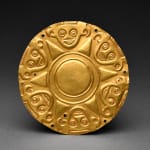Gold Pectoral Disc, 8th Century CE - 12th Century CE
Gold
height 14 cm
height 5 1/2 in
52.5 Grams
height 5 1/2 in
52.5 Grams
FJ.6324
While sailing the coast of Panama in 1502, Christopher Columbus reports having seen Indians with 'mirrors' of gold worn around their necks. No detailed description of these 'mirrors' was recorded,...
While sailing the coast of Panama in 1502, Christopher Columbus reports having seen Indians with "mirrors" of gold worn around their necks. No detailed description of these 'mirrors' was recorded, though we may speculate that unornamented disks were what the Spaniards meant. Pectorals or breastplates such as this beautiful example were an essential part of ornamentation, probably reserved for important individuals such as chiefs, warriors and shamans. Some have only an embossed border, while others are beautifully decorated. A common motif are faces or masks with staring eyes, and exposed teeth. There are six identical faces swirling around this disk, separated by triangles which appear like abstract rays radiating from the double-banded inner circle. The entire design is repeated on the reverse, creating an exact mirror image. The number of holes on this disk suggests it may have been designed to hang from a beam, free-spinning; as well as around the neck. It's circularity and perfect balance makes this disk seem to revolve forever; eternally fascinating and lovely.
1
of
13



